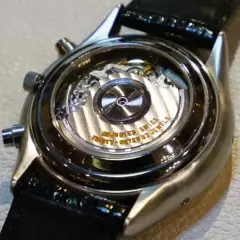Silver Case makers Identification
-
Recently Browsing
- No registered users viewing this page.
-
Topics
-
Posts
-
Thanks, do not understand "paper pushed over the top" part.
-
Thank you! I will take a look and see if I can get similar locally. I am speaking to another seller who sells vintage tools. It seems his father was a watchmaker since the 1950s. He said he has 3 potential machines for me, and that their spinning function works, but heating is no longer functioning. How much does that affect the value of a cleaner? It should be repairable with a modern PTC heating element right? I am not sure how much he will want for one of them. I might offer him depending on the machine, a price based on historical local listings for watch cleaning machines. For context, an Elma Super Elite w/o timer was sold for R1130 or $62/£49 in 2019, pictured below. While the lowest, a vintage National Electric which heating function didn't work for R230 or $13/£6, and highest was a beefy Fuji Auto Cleaner CL-101 for R2330 or $127/£100, also pictured below. So I am going to wait and see when he sends me pictures over email, and hopefully I can get a decently student priced watch cleaning machine. I have played with the idea of making my own, based of old Elma designs before.
-
Found this video on YouTube. This is how a professional poises a balance wheel to a very high degree of accuracy. Most large variations when regulating a watch in different positions is normally caused by the hairspring or the poise of the balance wheel.
-
By rjenkinsgb · Posted
I've been getting boxes to store the tools I already have. The Chinese jewel press came without any kind of box or case, so I started looking for something to suit that and ended up with some to take the bigger tools like the old open frame clock & pocketwatch mainspring winders & small winder kit, Jacot tool case etc. Old or antique wooden boxes can be cheaper than modern plastic stuff on ebay, and I prefer wood for these old or delicate tools. So, I ended up with three boxes: This one is just a bit wider and around the same height as my Boley staking set box, and will fit the jewel press with it bit sets, plus the Rex roller remover set: These two are rather larger, 14" & 16" wide, just basic plywood with corner bracing: They have all been abused, misused and bodged over the years! The smaller one turned out to be an antique travel writing slope! The original hinges and lock have gone & the tray appears to have been put together with bits of the writing surface, plus the original red & green baize being cut up and stuck in fragments in the base and on the underside. Sad. I've managed to find some hinges similar to the originals & a lock that may fit, plus ordered some felt and baize for the underside and linings. The outer surface is quite good, just needing a clean and polish. It started out nearer like this, another generally similar one on ebay that's not quite so far gone: The larger ones are just plain boxes; the latches and handle fittings are rusted but nothing special and easy to replace, plus some cracked corner joints. The worst butchery was at the back edge of the lid on the medium size one - someone had nailed it with carpet tacks! After removing those and re-gluing the back, all the nail holes are visible with glue showing in some of them. I'm often amazed at the levels of bodgery on some things. This has also had an initial clean up, with white vinegar and a melamine sponge - it's several shades lighter now, than when it arrived. Once the structural repairs are done & minor defects patched up, I will give them a refinish with shellac, if that seems compatible with the original varnish.
-









Recommended Posts
Join the conversation
You can post now and register later. If you have an account, sign in now to post with your account.
Note: Your post will require moderator approval before it will be visible.